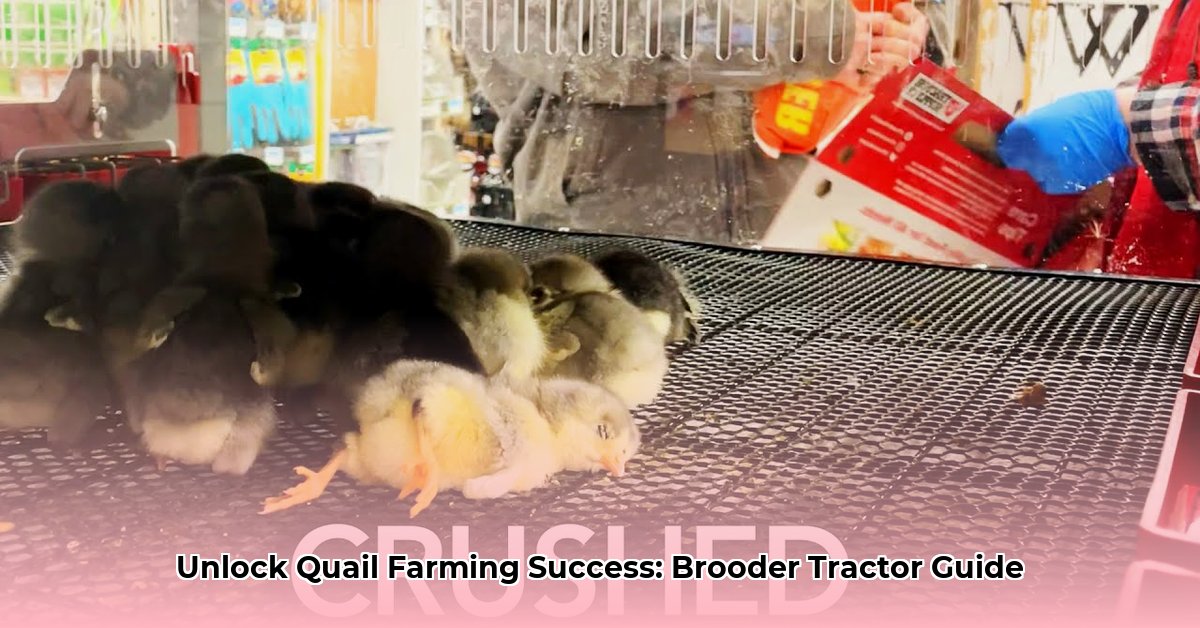
Raising quail can be a rewarding experience, but success hinges on providing your chicks with the right environment from day one. That starts with the perfect brooder. This guide will walk you through selecting, setting up, and maintaining a brooder from Tractor Supply, ensuring your quail thrive. We'll cover everything from choosing the right size and type to essential daily care tips. Ready to get started? For more on chicken brooders, check out this helpful resource: Tractor Supply Brooders.
Figuring Out Your Needs: Size and Space
Before you even think about brooder types, determine how many quail chicks you'll be raising. This dictates the size of the brooder you'll need. A dozen chicks require a smaller brooder than a hundred. Consider the location too—a spare room, a dedicated coop, or even a corner of your garage. Remember, easy cleaning is paramount for maintaining a healthy environment, so keep that in mind when selecting a location and brooder size. Do you have the space to comfortably accommodate the brooder and future growth of your flock?
Brooder Types: Exploring Your Options at Tractor Supply
Tractor Supply offers various brooder types, each with its own advantages and disadvantages. Let's break down the most common:
Electric Brooders: These use electricity to generate heat, offering precise temperature control. Ideal for indoor setups with reliable power, but be mindful of potential increases in your electricity bill.
Gas Brooders: Propane-powered, offering consistent warmth and a suitable choice for larger setups or areas with less-reliable electricity. Ensure proper ventilation for safety.
Heat Lamps: Simpler and more affordable, but require careful placement to prevent burns or creating unsafe hot spots. They need constant monitoring.
Hovering Brooders: Often used in larger commercial settings, these suspend a heat source above, creating a warm zone. Less portable than other options.
Choosing the Right Brooder: A Detailed Comparison
Selecting the right brooder involves weighing several factors. This table compares key features:
| Feature | Electric Brooder | Gas Brooder | Heat Lamp Brooder | Hovering Brooder |
|---|---|---|---|---|
| Temperature Control | Excellent | Very Good | Fair | Very Good |
| Initial Cost | Moderate | Higher | Low | Moderate |
| Ongoing Costs | Moderate (Electricity) | Moderate (Propane) | Low | Moderate |
| Maintenance | Easy | Moderate | Easy | Moderate |
| Safety | Generally Safe | Safe with caution | Requires close attention | Generally Safe |
| Portability | Less Portable | Less Portable | Highly Portable | Less Portable |
Remember, your local Tractor Supply staff can offer expert advice based on your specific needs and climate. Don't hesitate to ask for their recommendations!
Setting Up Your Brooder: A Step-by-Step Guide
Proper setup is crucial for your chicks' health. Follow these steps:
Thorough Cleaning: Before introducing your chicks, thoroughly clean and disinfect your brooder to prevent disease.
Comfortable Bedding: Use absorbent bedding like pine shavings, paper towels, or corn cob bedding. This keeps chicks dry and comfortable.
Precise Temperature Control: Maintain the correct temperature—around 95°F (35°C) for the first week, gradually decreasing by a few degrees each week. A thermometer is essential.
Easy Access to Food and Water: Provide fresh water and chick starter feed (25%+ protein is recommended) in appropriately sized feeders and drinkers.
Adequate Ventilation: Ensure good airflow to prevent ammonia buildup, which is harmful to your chicks.
Constant Monitoring: Regularly monitor temperature, water levels, and bedding, watching your chicks for any signs of illness or stress.
Ongoing Care and Maintaining a Clean Environment
Regular cleaning is vital for disease prevention. Remove soiled bedding daily and perform a thorough cleaning and disinfection of the entire brooder at least weekly. This proactive approach significantly reduces the risk of disease outbreaks. Remember, a clean brooder contributes to happy, healthy chicks! Is daily cleaning feasible given your schedule and flock size?
Key Considerations for Quail Brooder Success
Temperature: Critical, especially during the first week. Consistent monitoring prevents overheating and chilling. Aim for 95°F initially, decreasing gradually.
Ventilation: Prevents ammonia buildup and respiratory problems. Ensure sufficient airflow.
Hygiene: Cleanliness is paramount. Regular cleaning and disinfection are non-negotiable.
Monitoring: Regularly observe your chicks for signs of illness or stress. Early detection is crucial.
By following this guide and choosing the right brooder from Tractor Supply, you'll be well-equipped for a successful quail farming journey. Happy raising!